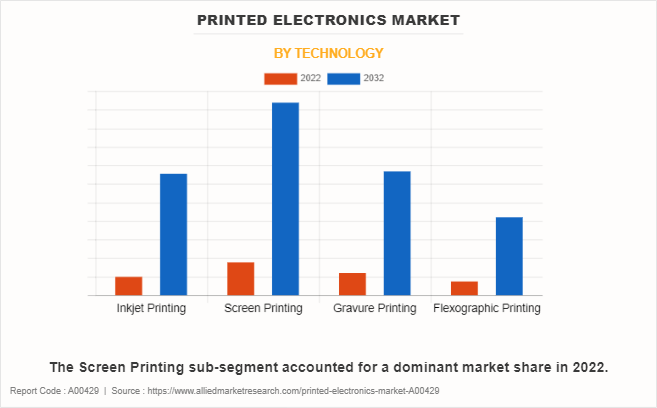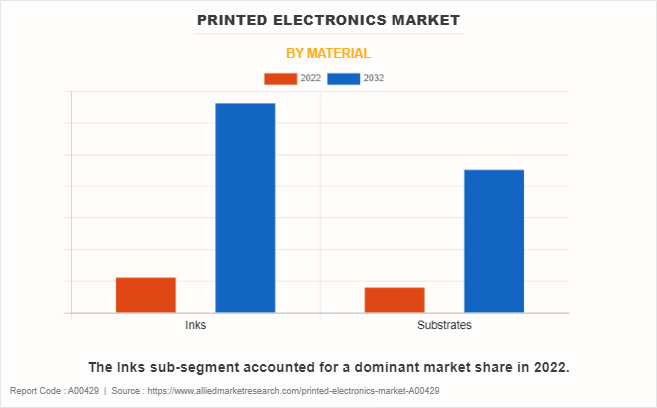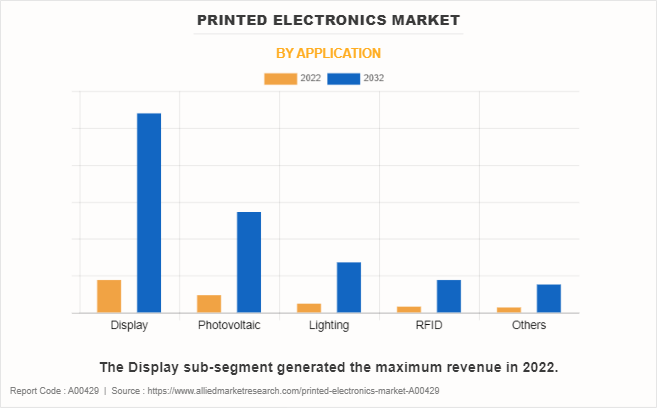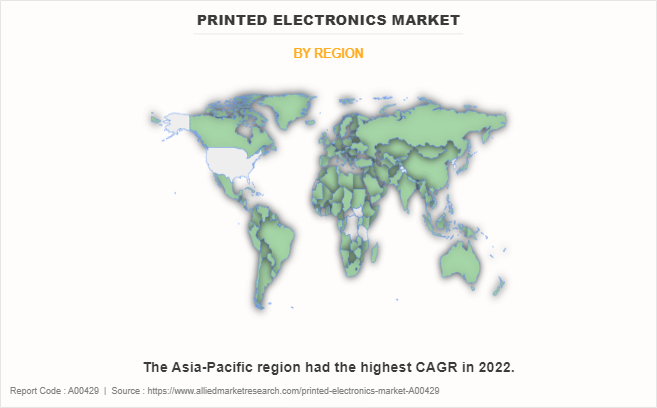Printed Electronics Market Research, 2032
The Global Printed Electronics Market growth was valued at $9.4 billion in 2022 and is projected to reach $55.7 billion by 2032, growing at a CAGR of 20.1% from 2023 to 2032.
The printed electronics market is expected to revolutionize electronic device production by enabling the fabrication of electrical circuits using additive technologies. Traditional electronics manufacturing depends on time-consuming and inefficient subtractive operations such as etching and milling. Printed electronics, on the other hand, employ a more ecologically friendly approach, depositing electronic inks onto substrates in a precise and controlled manner.
Not only does this additive manufacturing process save material waste, but it also offers new opportunities for constructing electronics on odd surfaces. The low cost and scalability of the printed electronics sector set it apart. For instance, laser and screen-printing technologies may be quickly adjusted for high-volume production, cutting manufacturing costs when compared to previous methods.

Printed electronics provide unrivaled design and customization flexibility. Traditional manufacturing techniques can need complicated and costly tooling for each design iteration. On the other hand, the digital nature of printing enables quick prototyping and easy design customization. This adaptability is especially useful in the creation of prototypes and small-scale production runs. Furthermore, the ability to print electrical components directly onto diverse substrates enables the incorporation of technology into unusual shapes and surfaces, bringing up new options for product designers. The printed electronics industry is making tremendous advances in the world of healthcare, notably in the creation of biocompatible devices. Due to the capacity to print electronics on flexible PCBs and biocompatible substrates, medical sensors and diagnostic equipment may adjust to the human body without causing discomfort. This offers new avenues for wearable health monitoring devices and implanted sensors, potentially revolutionizing patient care and diagnostics. In terms of resolution and accuracy, printing technologies have evolved tremendously. This translates into the capacity to print sophisticated electrical circuits with precise features, allowing for the manufacture of high-performance gadgets. Precision is critical in applications such as screens and sensors, where small-scale characteristics are required for maximum operation. The high resolution also helps to miniaturize electrical components, allowing for more compact and efficient systems.
When compared to traditional production processes, the printing resolution in printed electronics is frequently poorer. With today's printing technologies, the accuracy necessary for sophisticated circuits and components is not always possible. This lesser resolution can lead to decreased device performance and reliability, particularly in applications that need precise features, such as high-density integrated circuits. Another major disadvantage is the difficulty of incorporating printed components into current production processes. Industries that have long depended on traditional electronic production may find it difficult to adapt to the printed electronics needs. The necessity for specialized printing equipment and knowledge can be a barrier to wider adoption, especially for small and medium-sized businesses with limited resources. Variations in the printing process can have an impact on the performance of printed electronics growth projections. Variations in electrical characteristics among printed components might be caused by inconsistencies in ink deposition, substrate quality, or curing methods. A fundamental problem that must be solved to enable the dependable functioning of printed electronics in mass production is achieving uniformity and reproducibility in the production process.
The adoption of printed electronics opens an array of options in a variety of sectors. In healthcare, for instance, the development of smart, wearable sensors has the potential to transform patient monitoring. The potential for enhancing healthcare outcomes ranges from flexible patches that measure vital signs to smart fabrics that can monitor glucose levels. Furthermore, the use of printed electronics in diagnostic equipment has the potential to make healthcare more accessible and affordable. The prospects provided by printed electronics have the potential to dramatically impact the consumer electronics market. Displays that are flexible and lightweight may be fitted into unusual surfaces, converting commonplace things into interactive gadgets. This opens the door to new product designs and user experiences. The automotive sector, too, may benefit from printed electronics for the creation of flexible displays, sensors, and other components. The future of printed electronics is bright, thanks to continuous R&D efforts. As material science and printing technology progress, the performance and capabilities of printed electronic devices are predicted to skyrocket. As a result, the expansion of printed electronics across several sectors will accelerate. Energy harvesting is one area where the increase is expected. Printed solar cells and energy storage devices provide a sustainable power source for electronic devices ranging from small sensors to bigger applications such as smart buildings. The incorporation of energy-harvesting capabilities into printed electronics is consistent with the worldwide move toward renewable energy and energy-efficient products. These factors are anticipated to boost the printed electronics market opportunity.
The key printed electronics market share by company profiled in this report includes Samsung Electronics Co. Ltd, LG Display Co. Ltd, Molex LLC, Agfa-Gevaert Group, Palo Alto Research Center Incorporated (PARC), DuPont de Nemours, Inc, Nissha Co. Ltd, BASF, Nova Centrix, and E Ink Holdings Inc. Research and Development (R&D) and focus on sustainable and flexible materials are common strategies followed by major printed electronics companies. For instance, on Oct. 13, 2021, Panasonic Industrial Devices Sales Company of America, a division of Panasonic Corporation of North America, presented BEYOLEXTM, a new thermoset stretchable film for printed electronics, through its electronic materials division. The unique material is based on Panasonic researchers at the Electronic Materials laboratory in Kadoma, Osaka, Japan, who created a proprietary non-silicone thermoset polymer chemistry.
The printed electronics market report is segmented into material, technology, device, and region. Based on material, the market is bifurcated into ink and substrate. By technology, the market is classified into inkjet, screen printing, gravure printing, and flexographic. Depending on the device, the market is classified into display, photovoltaic, lighting, RFID, and others. Based on region, the printed electronics market size by country is analyzed across North America, Europe, Asia-Pacific, and LAMEA.
Segment Overview
The printed electronics market overview is segmented into Technology, Material, and Application.
By technology, the screen sub-segment dominated the global printed electronics market share in 2022. Screens in printed electronics are being incorporated into dashboards, mirrors, and even windows in the vehicle sector. This trend improves the driving experience by incorporating cutting-edge navigation, entertainment, and safety systems. Furthermore, the ability to print electronic components enables more simplified and visually beautiful interior designs. The flexibility and lightweight of printed circuit boards PCB displays have pushed important breakthroughs in wearable technology. These screens offer seamless integration into ordinary products, boosting user experience and usefulness. They range from smart apparel to flexible wrist displays. Wearable gadgets that can monitor vital signs using inconspicuous, flexible displays have assisted the healthcare industry. Printed electronics with screens enable quick prototyping and customization. The capacity to rapidly iterate ideas and manufacture unique electrical components is crucial for R&D. Rapid prototyping speeds up the invention cycle, enabling speedier product development and time-to-market for new electrical products.

Based on material, the ink sub-segment dominated the global printed electronics market share in 2022. Ink compositions are not confined to delivering just electrical conductivity. Researchers are constantly designing inks with varied functionality, such as semiconducting, insulating, and even biocompatible characteristics. This makes it easier for the development of multifunctional gadgets such as electronic skin with sensing capabilities or smart packaging with built-in sensors for real-time monitoring. The comparatively low cost of entry into printed circuit boards PCB, assisted by the availability of inks and printing equipment, makes this technology accessible to educational institutions and researchers. This accessibility fosters grassroots innovation by creating a collaborative environment in which students and researchers may experiment with new ideas and contribute to the progress of printed electronics. Designers may now see and manufacture electrical gadgets with unparalleled variety due to the development of specialized inks. The versatility of ink-based printing technologies allows for a wide range of designs, from delicate circuit patterns to large-scale displays. This adaptability is useful in areas such as fashion, where wearable technology may be easily integrated into apparel, and architecture, where electrical functionality can be incorporated into building materials.

Depending on the application, the display sub-segment dominated the global printed electronics market share in 2022. Printed displays help to realize the idea of universal computing by offering information access in a variety of settings. Integrating displays into ordinary products such as packaging, clothes, or even built-in surfaces allows consumers to easily access information. This has implications for improving user experiences in retail, adding interactive components to product packaging, and building immersive environments that seamlessly combine the real and digital worlds. Displays are critical components of human-machine interaction, serving as a visual interface through which people interact with electronic equipment. This applies to improved user experiences in printed electronics via interactive surfaces, touch-sensitive screens, and augmented reality applications. Display integration with wearable technology, for instance, gives up new options for gesture-based controls, real-time health monitoring, and personalized notifications, resulting in a more personalized experience.

Based on region, Asia-Pacific dominated the global printed electronics market in 2022. The Asia-Pacific area is seeing a trend toward miniaturization of electronic equipment, driven by the desire for small and lightweight solutions. Printed electronics play a vital part in this movement by enabling the production of smaller and more efficient electrical components. This, in turn, helps to the development of sleeker consumer gadgets, portable medical devices, and small vehicle technology. Printed electronics are revitalizing the Asia-Pacific industrial industry by creating new opportunities for development and employment. The adoption of this technology has resulted in the formation of specialized manufacturing facilities, providing jobs, and propelling economic development. As the industry expands, it adds to the region's overall competitiveness in the global market. The adoption of printed electronics in the Asia-Pacific area is encouraging industry diversity. Printed Electronics allows innovation in a variety of industries, from consumer electronics to healthcare devices, automotive applications, and beyond. This diversity not only strengthens economic resilience but also places the area as a global leader in the development and use of this transformational technology.

Impact of COVID-19 on the Printed Electronics Industry
The epidemic has led to an increase in the demand for printed electronic products. The rise in emphasis on health and safety standards has resulted in a spike in the usage of touchless technology. Touchless interfaces, such as touchless sensors, touchless displays, and flexible electronics, have all benefited from advances in printed electronics.
These advancements have found use in a variety of industries, such as healthcare, retail, and public settings, where minimizing physical touch has been a concern. Due to this, the pandemic functioned as a catalyst for the innovation and widespread acceptance of touchless technologies, propelling growth in the printed electronics market. During the pandemic, remote working has become the new standard, resulting in the demand for technological equipment.
- As more people work and study from home, the demand for printed electronic components used in products such as smart home systems, wearable electronics, and e-learning tools has increased significantly. This increase in demand has provided opportunities for innovation in printed electronics, driving firms to develop more efficient and cost-effective printing procedures to satisfy the market's shifting demands.
Key Benefits For Stakeholders
- This report provides a quantitative analysis of the market segments, current trends, estimations, and dynamics of the printed electronics market analysis from 2022 to 2032 to identify the prevailing printed electronics market opportunities.
- The market research is offered along with information related to key drivers, restraints, and opportunities.
- Porter's five forces analysis highlights the potency of buyers and suppliers to enable stakeholders to make profit-oriented business decisions and strengthen their supplier-buyer network.
- In-depth analysis of the printed electronics market segmentation assists in determining the prevailing market opportunities.
- Major countries in each region are mapped according to their revenue contribution to the global market.
- Market player positioning facilitates benchmarking and provides a clear understanding of the present position of the market players.
- The report includes an analysis of the regional as well as global printed electronics market trends, key players, market segments, application areas, and market growth strategies.
Printed Electronics Market Report Highlights
| Aspects | Details |
| Market Size By 2032 | USD 55.7 billion |
| Growth Rate | CAGR of 20.1% |
| Forecast period | 2022 - 2032 |
| Report Pages | 310 |
| By Technology |
|
| By Material |
|
| By Application |
|
| By Region |
|
| Key Market Players | Samsung Electronics Co., Ltd., E Ink Holdings Inc., NovaCentrix, Agfa-Gevaert Group, Molex LLC, BASF SE, Palo Alto Research Center Incorporated (PARC), DuPont (EI) De Nemours, LG Display Co., Ltd., Nissha Co. Ltd |
The printed electronics market is expected to witness considerable growth due to the increase in the demand for flexible and lightweight electronic devices globally.
The major growth strategies adopted by the printed electronics market players are research and development (R&D) and focus on sustainable and flexible materials.
Asia-Pacific will provide more business opportunities for the global printed electronics market in the future.
Samsung Electronics Co., Ltd., LG Display Co., Ltd., Molex LLC, Agfa-Gevaert Group, Palo Alto Research Center Incorporated (PARC), DuPont de Nemours, Inc., Nissha Co., Ltd., BASF, Nova Centrix, and E Ink Holdings Inc. are the major players in the printed electronics market.
The ink printed electronics sub-segment of the material segment acquired the maximum share of the global printed electronics market in 2022.
Consumer electronics manufacturers companies and internet of things (IoT) are the major customers in the global printed electronics market.
The report provides an extensive qualitative and quantitative analysis of the current trends and future estimations of the global printed electronics market from 2022 to 2032 to determine the prevailing opportunities.
Flexible and lightweight electronic devices are expected to experience a growth in adoption.
Internet of Things (IoT), increase in the investment and partnerships of printed electronics, and surge in demand for advancements in materials industry drive the global printed electronics market.
Loading Table Of Content...
Loading Research Methodology...


